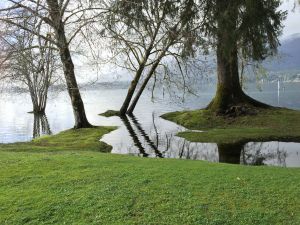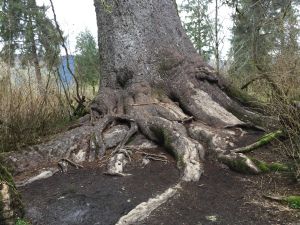Article
Communing With a Giant on Cancer, Life
Author(s):
Nature offers many role models for coping with cancer's challenges.
This past week I attended the Rainforest Writers Village with about 20 other science fiction writers. The resort where we stayed is on the southeast tip of Lake Quinault, adjacent to the southern border of the Olympic National Park in Washington State. It was quiet, beautiful, and slow-paced—the perfect place to take a break from everything and focus on my writing.
After lunch the first day, I decided to take a meditation walk along the lakeshore in hopes of absorbing some of the abundant tranquility. When I walked this same path 14 months ago, Washington was experiencing a drought. This year, we’d had our wettest winter ever, and the level of the lake reflected the additional rainfall. Tree roots normally anchored on the mossy bank now stood in a couple of feet in water.

The first hours of the retreat were graced with several downpours, but for the moment, the rain had stopped. I took deliberate steps along the soggy pathway, carefully placing my feet to avoid adding another fall to my medical file. I concentrated on taking slow, deep breaths. Gradually my thoughts came to rest in the moment. I smelled the surrounding evergreens, felt the moist rainforest air, heard the enthusiastic creek swollen with runoff, saw a raven stepping carefully on puddled lawn.
I meandered past deserted trailer slots and a closed bathhouse to the end of the campground, where stood the World’s Largest Sitka Spruce Tree. There I encountered a couple of other writers who were also taking a break from their labors. We imagined the tree was lonely and had called for company. Eventually, the others wandered off, leaving me alone with the tree and my thoughts.

Despite hundreds of droughts and downpours, the 10,000-year-old giant before me stood firmly anchored in the earth, continually adding rings to its impressive girth. The diameter of its trunk exceeded twice my armspan, and the massive roots spread at least twice again as far.
Standing under its broad arms, dwarfed by its great size and age, I was struck by both the difference and the similarity between us. It had outlived its contemporaries by decades, even centuries. I likely would not reach the average life span for my species. Yet neither of us knew for certain how much longer we would live on this earth. All we truly had was the here and now.
I felt drawn to its strength and broad grounding. I extended one arm towards the giant, one arm back towards my life, and positioned my legs to form the “Warrior II” pose I’d learned in yoga class last year. I felt the earth solidly beneath my feet, and drew deeply on the rainforest air. In that moment, I was an old growth tree, extending my branches over my wide root base, absorbing the goodness of the earth and clean mountain water, cleansing my system, in harmony with my environment. The rain clouds parted, and sun streamed through the evergreen canopy, highlighting our bond.
The moment passed, and I returned to my own body that was sustained by anticancer drugs. Yet, as I walked away from the ancient tree, I felt I had gained stature and substance. Regardless of how much time I had remaining, I would seek balance and grounding while raising my face to the sun.
Back at my cabin, I started writing, conscious of the lake, evergreens and bits of light from the sinking sun.




